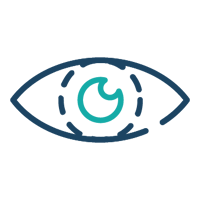An estimated 16.4 million adults are affected by retinal vein occlusion (RVO) (2.5 million due to central retinal vein occlusion and 13.9 million due to branch retinal vein occlusion).
Prior to going into how retinal vein occlusion is detected using an ERG, let's define what retinal vein occlusion is. Retinal vein occlusion occurs when the small vessels that carry blood away from the retina are blocked. As a consequence, the vein now cannot drain blood properly from the retina, resulting in bleeding and fluid leakage onto the retina from the blocked blood vessel, which can cause painless loss of vision. The reason why this can cause painless loss of vision is because it can lead to macular edema.
How can retinal vein occlusion cause macular edema?
Macular edema occurs because all the blood that flowed back onto the retina can cause leakage and swelling beneath the macula. The macula is the part of your eye that's responsible for sharp, central vision. And when there's swelling and leakage underneath the macula, then this can result in a decrease in your vision.
How can retinal vein occlusion cause neovascularization?
A retinal vein occlusion can also result in neovascularization. It means there is new blood vessel growth on the retina. This occurs because of that blocked vein, blood can get to certain areas of the retina, so that area of the retina is deprived of oxygen and nutrients. In response, the body forms new blood vessels in that area. This is problematic because the new blood vessels that form are weak, leaky, and not normal, so they could break, leading to further swelling, and bleeding. It can also lead to eventual retinal detachments in severe cases of vein occlusions.
Who is going to be affected by vein occlusions?
Generally, vein occlusions affect people with conditions that affect blood flow or people who fail to properly manage these medical conditions. Thus, for example, people who suffer from either diabetes, high blood pressure, or cholesterol, if they're not well managed, they're more likely to develop vein occlusions.
What are the symptoms of retinal vein occlusion?
Some patients have subtle symptoms, while others have more obvious symptoms, like blurred vision or complete loss of vision. The vision can deteriorate over the next few hours or days. Vision loss can also occur suddenly in some cases. Typically, the vein occlusions are unilateral, meaning they occur primarily in just one eye.
What are the different types of a retinal vein occlusion?
There are two types of vein occlusion:
- Branch retinal vein occlusion: Branch vein occlusion only affects one area of the retina.
- Central retinal vein occlusion: Central retinal vein occlusions means that all the different areas of the retina are affected.
How is retinal vein occlusion diagnosed?
- Dilating Eyes - Our first step in diagnosing vein occlusion is to dilate your eyes. We examine the back of the eye to determine which parts of the retina are affected, as well as to look for any bleeding or swelling.
- OCT - Besides dilating your eyes, we also perform several different imaging procedures on you. So we have an OCT machine that can examine all the layers of the retina. We'll also be able to see whether or not there is any swelling or edema in the macular area or an area of the retina.
- Fluorescein angiography - Fluorescein angiography is another technique that can be used to diagnose vein occlusions. We will refer you out to a specific site for this test, and essentially what they will do is inject dye into a vein in your arm. The dye will travel to the blood vessels in your eye. This will allow us to see the vessels and see if there is any sort of blockage.
- RETeval ERG - A RETeval ERG will give us comprehensive information about the health of your retina. Your retina is the part of the eye that responds to light when it enters your eye. The light signal will be converted into an electrical signal that your brain will respond to. The RETeval ERG measures both the speed and the strength of the electrical response your retina produces when it is stimulated with a series of flashes of light. Signals are collected through sensor strips, which are small stickers that will be placed directly under the eye. When the speed response is too slow or the strength is weak, then this indicates that there is a functional stress on the retina and we should monitor you more closely. It can also give us information about predicting vision loss as it progresses.
How can retinal vein occlusion be treated with the assistance of an ERG?
What's great about the ERG is it can better allow us to monitor your response to treatment. Typically, the treatment for vein occlusions involves either injecting various different medications into your eyes to stop swelling and stop new blood vessels from growing. We would also use various lasers in your eyes to prevent these weak leaky blood vessels from growing. So the RETeval ERG just better helps us to manage you. We use the OCT to find out about the structure of the retina, and this ERG gives us further information about the function of the retina so that we can manage you better or predict the progression of your vision loss.











